oil pressure CHEVROLET CAMARO 1995 4.G Owners Manual
[x] Cancel search | Manufacturer: CHEVROLET, Model Year: 1995, Model line: CAMARO, Model: CHEVROLET CAMARO 1995 4.GPages: 388, PDF Size: 19.69 MB
Page 10 of 388
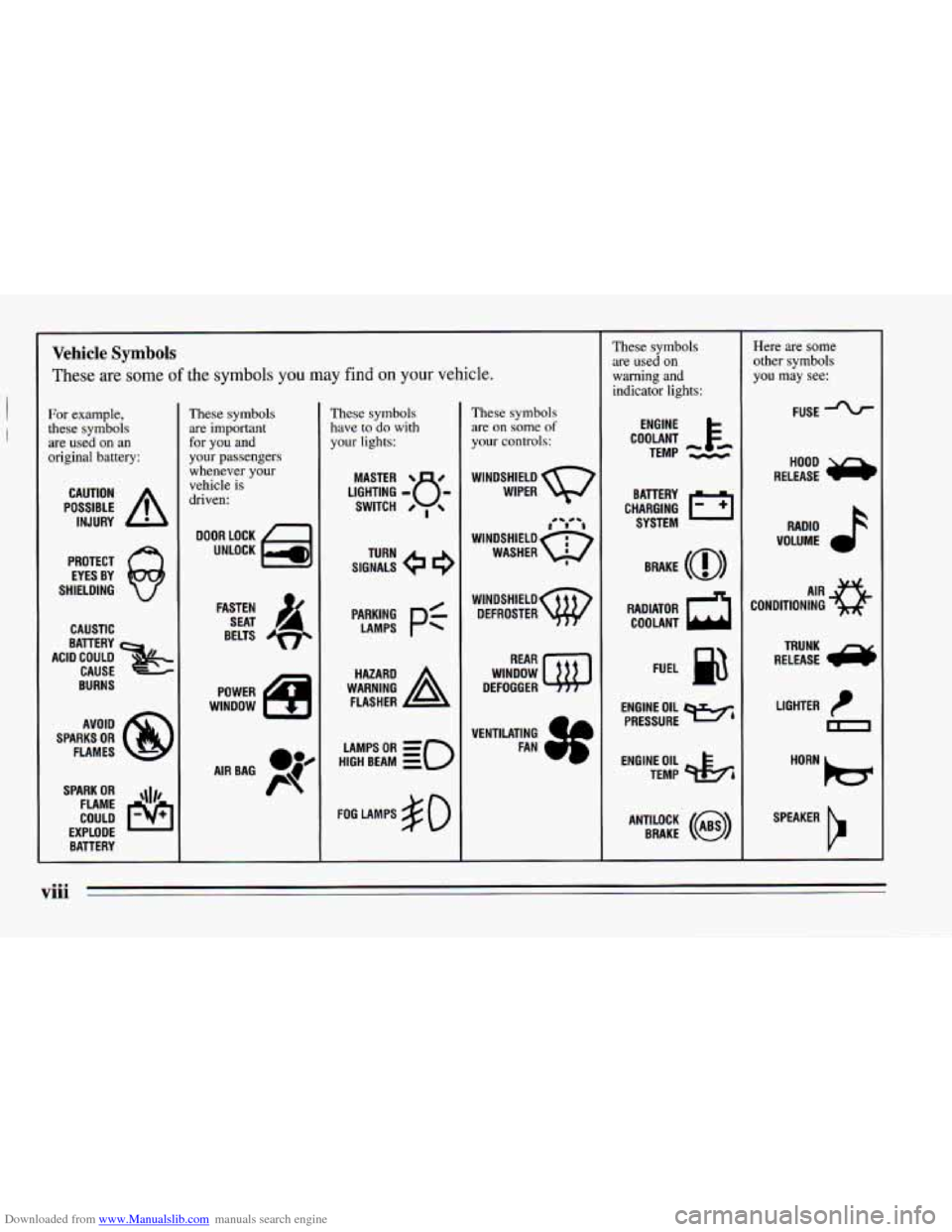
Downloaded from www.Manualslib.com manuals search engine Vehicle Symbols
These are some of the symbols you may find on your vehicle.
For example,
these symbols
are used
on an
original battery:
POSSIBLE A
CAUTION
INJURY
PROTECT EYES BY
SHIELDING
Q
CAUSTIC
ACID COULD
BATTERY
CAUSE
BURNS
AVOID
SPARKS
OR
FLAMES
SPARK
OR ,111,
COULD FLAME
EXPLODE BATTERY
These symbols
are important
for you and
your passengers
whenever your
vehicle
is
driven:
FASTEN SEAT 4
BELTS
POWER
WINDOW
These symbols
have to do with
your lights:
SIGNALS e
TURN
PARKING
PC
LAMPS
WARNING
A
HAZARD
FLASHER
These symbols are on
some of
your controls:
WINDSHIELD WIPER w
WINDsHIELDw DEFROSTER
WINDOW
DEFOGGER
VENTILATING FAN
HIGH BEAM =
FOG LAMPS $0
These symbols
are used
on
warning and
indicator lights:
COOLANT Fe
TEMP --
ENGINE
CHARGING
I-1
BATTERY SYSTEM
RADIATOR
a
COOLANT FUEL
ENGINE OIL
w,
PRESSURE
TEMP OIL
pk,
ANTILOCK (@)
BRAKE
Here are some
other symbols
you may see:
FUSE -%-
RADIO >
VOLUME
CONDITIONING RELEASE
e
TRUNK
LIGHTER
m
SPEAKER
b
viii
~
Page 128 of 388
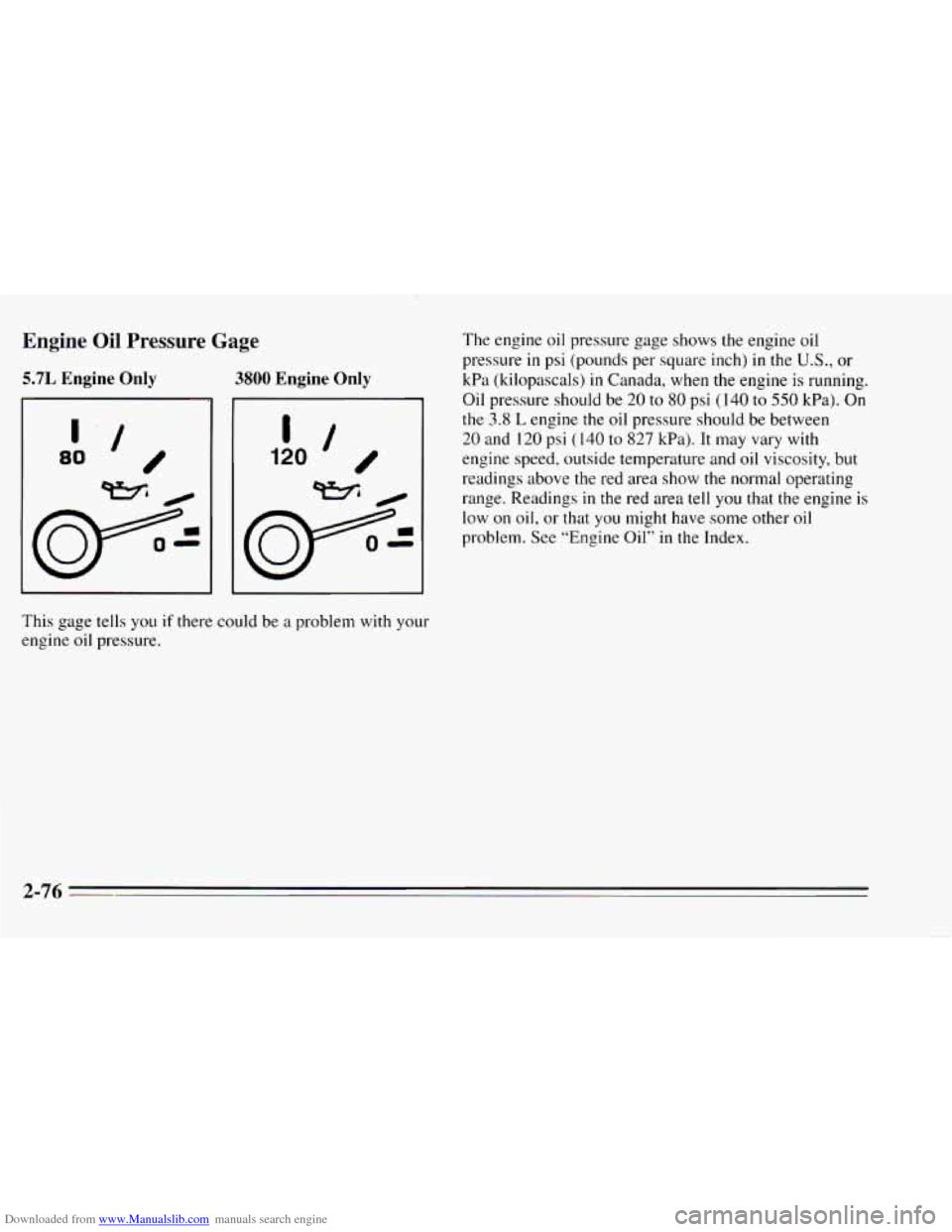
Downloaded from www.Manualslib.com manuals search engine Engine Oil Pressure Gage
5.7L Engine Only 3800 Engine Only
80 “I 0 120 I! /
This gage tells you if there could be a problem with your
engine
oil pressure. The
engine
oil pressure gage shows the engine oil
pressure
in psi (pounds per square inch) in the U.S., or
kPa (kilopascals)
in Canada, when the engine is running.
Oil pressure should be
20 to 80 psi (140 to 550 kPa). On
the
3.8 L engine the oil pressure should be between
20 and 120 psi (140 to 827 kPa). It may vary with
engine speed, outside temperature and oil viscosity, but
readings above the red area show
the normal operating
range. Readings
in the red area tell you that the engine is
low on oil, or that you might have some other oil
problem. See “Engine Oil” in the Index.
2-76 -
Page 178 of 388
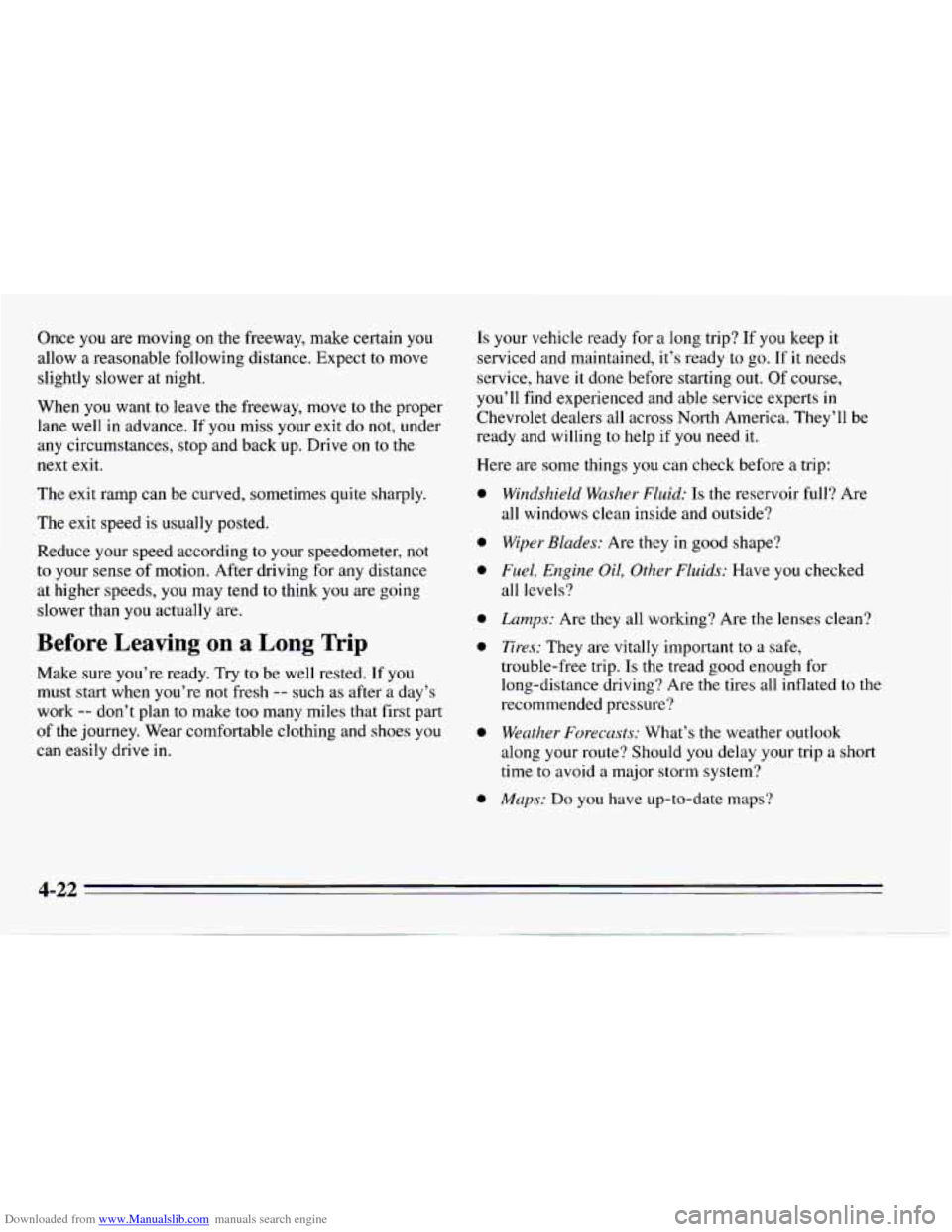
Downloaded from www.Manualslib.com manuals search engine Once you are moving on the freeway, make certain you
allow a reasonable following distance. Expect to move
slightly slower at night.
When you want to leave the freeway, move
to the proper
lane well in advance.
If you miss your exit do not, under
any circumstances, stop and back up. Drive
on to the
next exit.
The exit ramp can be curved, sometimes quite sharply.
The exit speed is usually posted.
Reduce your speed according to your speedometer,
not
to your sense of motion. After driving for any distance
at higher speeds, you may tend to think you are going
slower than you actually are.
Before Leaving on a Long Trip
Make sure you’re ready. Try to be well rested. If you
must start when you’re not fresh -- such as after a day’s
work
-- don’t plan to make too many miles that first part
of the journey. Wear comfortable clothing and shoes
you
can easily drive in.
Is your vehicle ready for a long trip? If you keep it
serviced and maintained, it’s ready to
go. If it needs
service, have it done before starting out.
Of course,
you’ll find experienced and able service experts
in
Chevrolet dealers all across North America. They’ll be
ready and willing to help if you need it.
Here are some things you can check before
a trip:
0
0
0
0
0
0
0
Windshield Washer Fluid: Is the reservoir full? Are
all windows clean inside and outside?
Wiper Blades: Are they in good shape?
Fuel, Engine Oil, Other Fluids: Have you checked
all levels?
Lumps: Are they all working? Are the lenses clean?
Tires: They are vitally important to a safe,
trouble-free trip.
Is the tread good enough for
long-distance driving? Are
the tires all inflated to the
recommended pressure?
Weather Forecasts: What’s the weather outlook
along your route? Should
you delay your trip a short
time to avoid a major storm system?
Maps: Do you have up-to-date maps?
4-22
Page 291 of 388
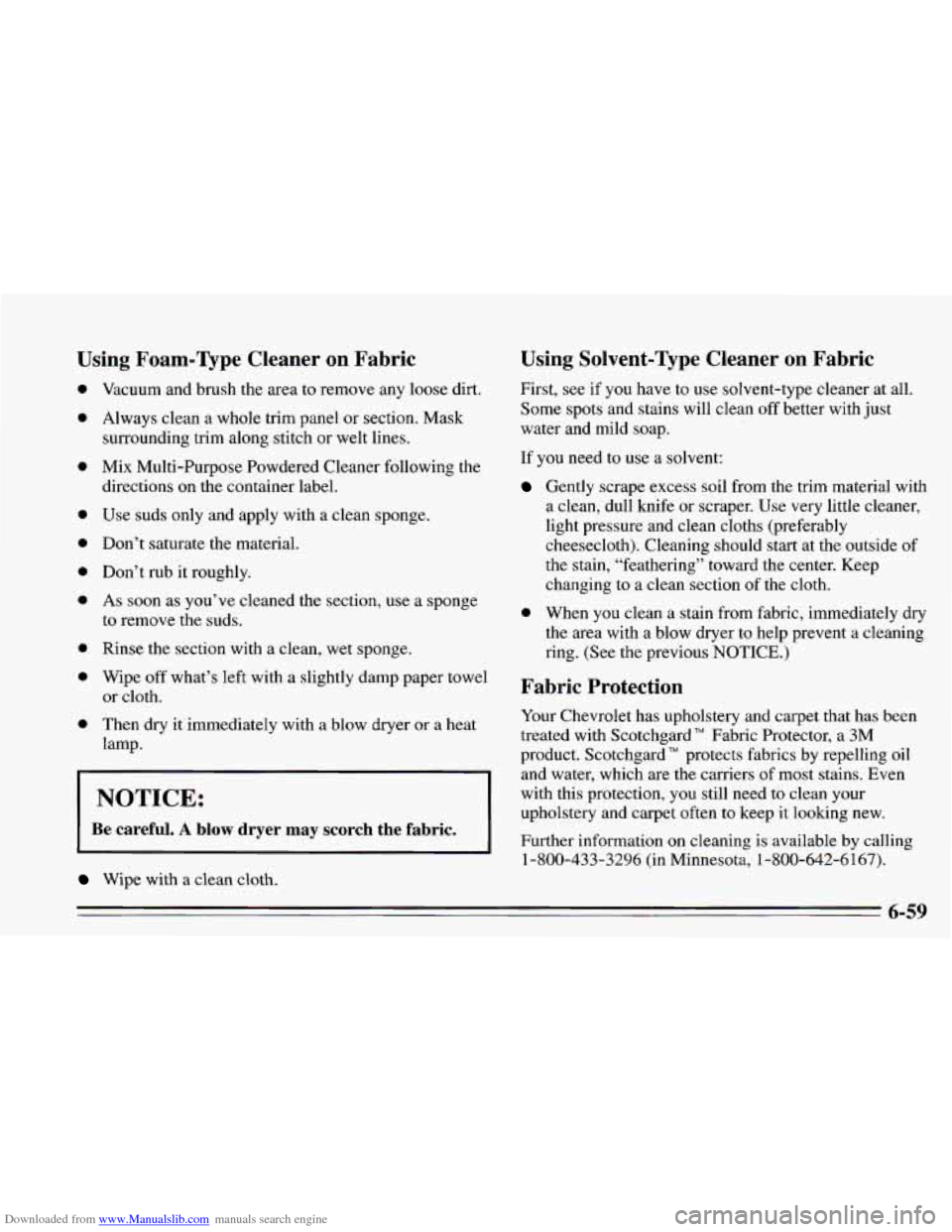
Downloaded from www.Manualslib.com manuals search engine Using Foam-Type Cleaner on Fabric
0
0
0
0
0
0
0
0
0
0
Vacuum and brush the area to remove any loose dirt.
Always clean a whole trim panel or section. Mask
surrounding trim along stitch or welt lines.
Mix Multi-Purpose Powdered Cleaner following the
directions on the container label.
Use suds only and apply with a clean sponge.
Don’t saturate the material.
Don’t rub it roughly.
As soon as you’ve cleaned the section, use a sponge
to remove the suds.
Rinse the section with a clean, wet sponge.
Wipe
off what’s left with a slightly damp paper towel
or cloth.
Then dry it immediately with a blow dryer or a heat
lamp.
~~~
NOTICE:
Be careful. A blow dryer may scorch the fabric.
Wipe with a clean cloth.
Using Solvent-Qpe Cleaner on Fabric
First, see if you have to use solvent-type cleaner at all.
Some spots and stains will clean off better with just
water and mild soap.
If you need to use a solvent:
Gently scrape excess soil from the trim material with
a clean, dull knife or scraper. Use very little cleaner,
light pressure and clean cloths (preferably
cheesecloth). Cleaning should start at the outside of
the stain, “feathering” toward the center. Keep
changing to
a clean section of the cloth.
0 When you clean a stain from fabric, immediately dry
the area with a blow dryer to help prevent a cleaning
ring. (See the previous NOTICE.)
Fabric Protection
Your Chevrolet has upholstery and carpet that has been
treated with Scotchgard” Fabric Protector,
a 3M
product. Scotchgard
TM protects fabrics by repelling oil
and water, which are the carriers of most stains. Even
with this protection, you still need to clean your
upholstery and carpet often to keep it looking new.
Further information on cleaning is available by calling
1-800-433-3296 (in Minnesota, 1-800-642-6167).
6-59
Page 295 of 388
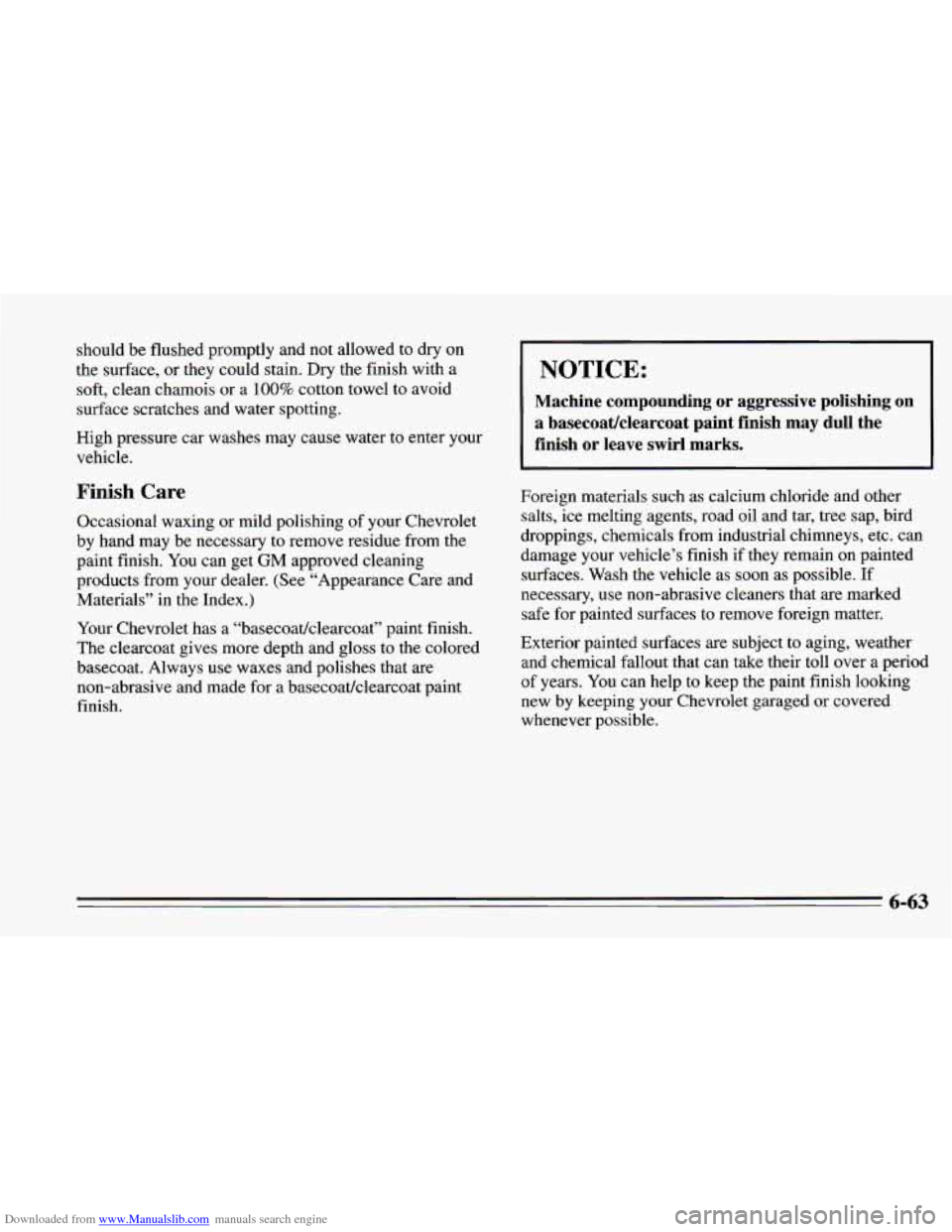
Downloaded from www.Manualslib.com manuals search engine should be flushed promptly and not allowed to dry on
the surface, or they could stain.
Dry the finish with a
soft, clean chamois or a
100% cotton towel to avoid
surface scratches and water spotting.
High pressure car washes may cause water to enter your
vehicle.
Finish Care
Occasional waxing or mild polishing of your Chevrolet
by hand may be necessary to remove residue from the
paint finish. You can get
GM approved cleaning
products from your dealer. (See “Appearance Care and
Materials” in the Index.)
Your Chevrolet has a “basecoatklearcoat” paint finish.
The clearcoat gives more depth and gloss to
the colored
basecoat. Always use waxes and polishes that are
non-abrasive and made for a basecoatlclearcoat paint
finish.
I NOTICE:
Machine compounding or aggressive polishing on
a basecoatlclearcoat paint finish may dull the
finish or leave swirl marks.
Foreign materials such as calcium chloride and other
salts, ice melting agents, road oil and tar, tree sap, bird
droppings, chemicals from industrial chimneys, etc. can
damage your vehicle’s finish if they remain on painted
surfaces. Wash the vehicle as soon as possible. If
necessary, use non-abrasive cleaners that are marked
safe
for painted surfaces to remove foreign matter.
Exterior painted surfaces are subject to aging, weather
and chemical fallout that can take their toll over
a period
of years.
You can help to keep the paint finish looking
new
by keeping your Chevrolet garaged or covered
whenever possible.
6-63
Page 320 of 388
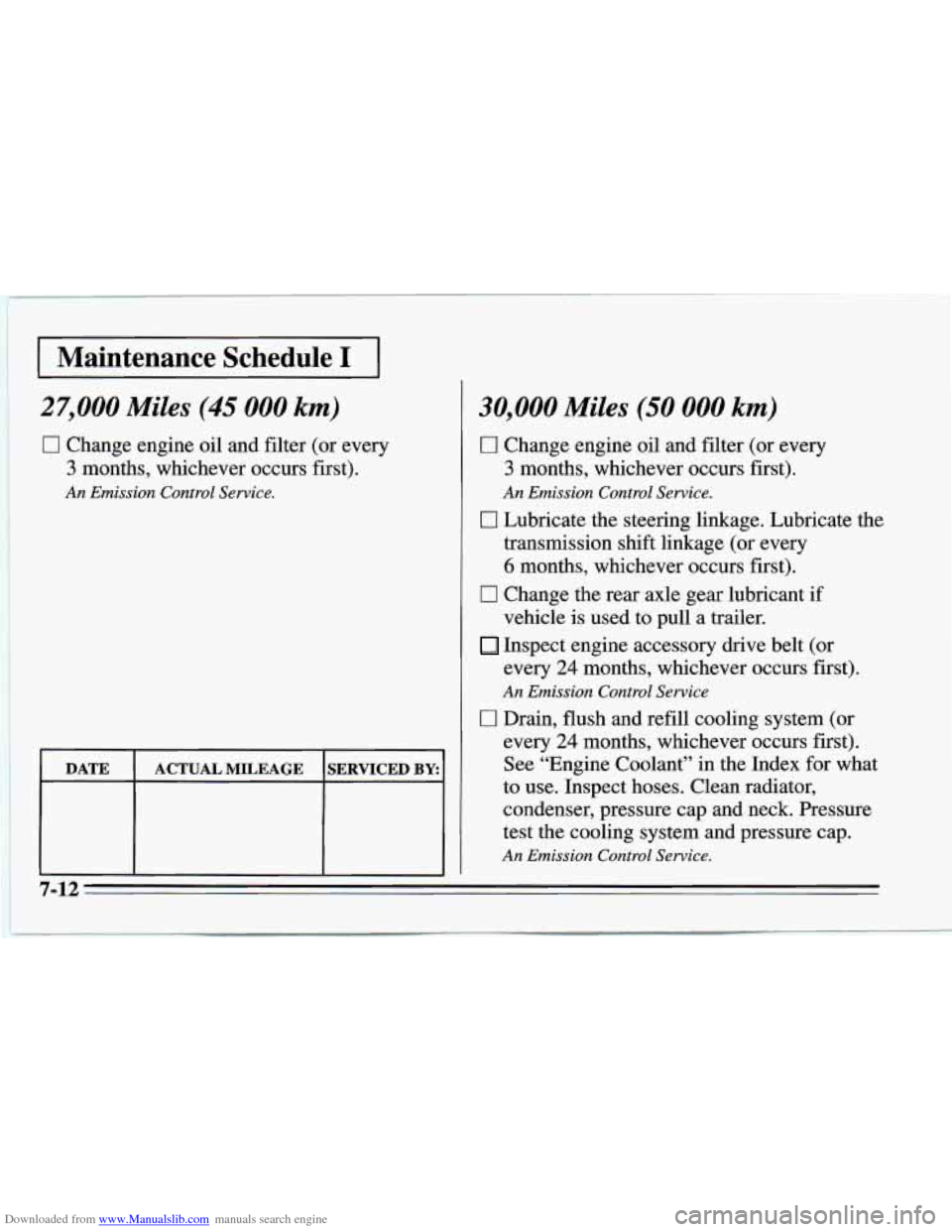
Downloaded from www.Manualslib.com manuals search engine I Maintenance Schedule I I
27,000 Miles (45 000 km)
0 Change engine oil and filter (or every
3 months, whichever occurs first).
An Emission Control Service.
30,000 Miles (50 000 km)
0 Change engine oil and filter (or every
3 months, whichever occurs first).
An Emission Control Sewice.
0 Lubricate the steering linkage. Lubricate the
transmission shift linkage (or every
6 months, whichever occurs first).
0 Change the rear axle gear lubricant if
vehicle is used to pull a trailer.
Inspect engine accessory drive belt (or
every
24 months, whichever occurs first).
An Emission Control Service
0 Drain, flush and refill cooling system (or
every
24 months, whichever occurs first).
See “Engine Coolant” in the Index for what
to use. Inspect hoses. Clean radiator,
condenser, pressure cap and neck. Pressure
test the cooling system and pressure cap.
An Emission Control Service.
7-12
Page 328 of 388
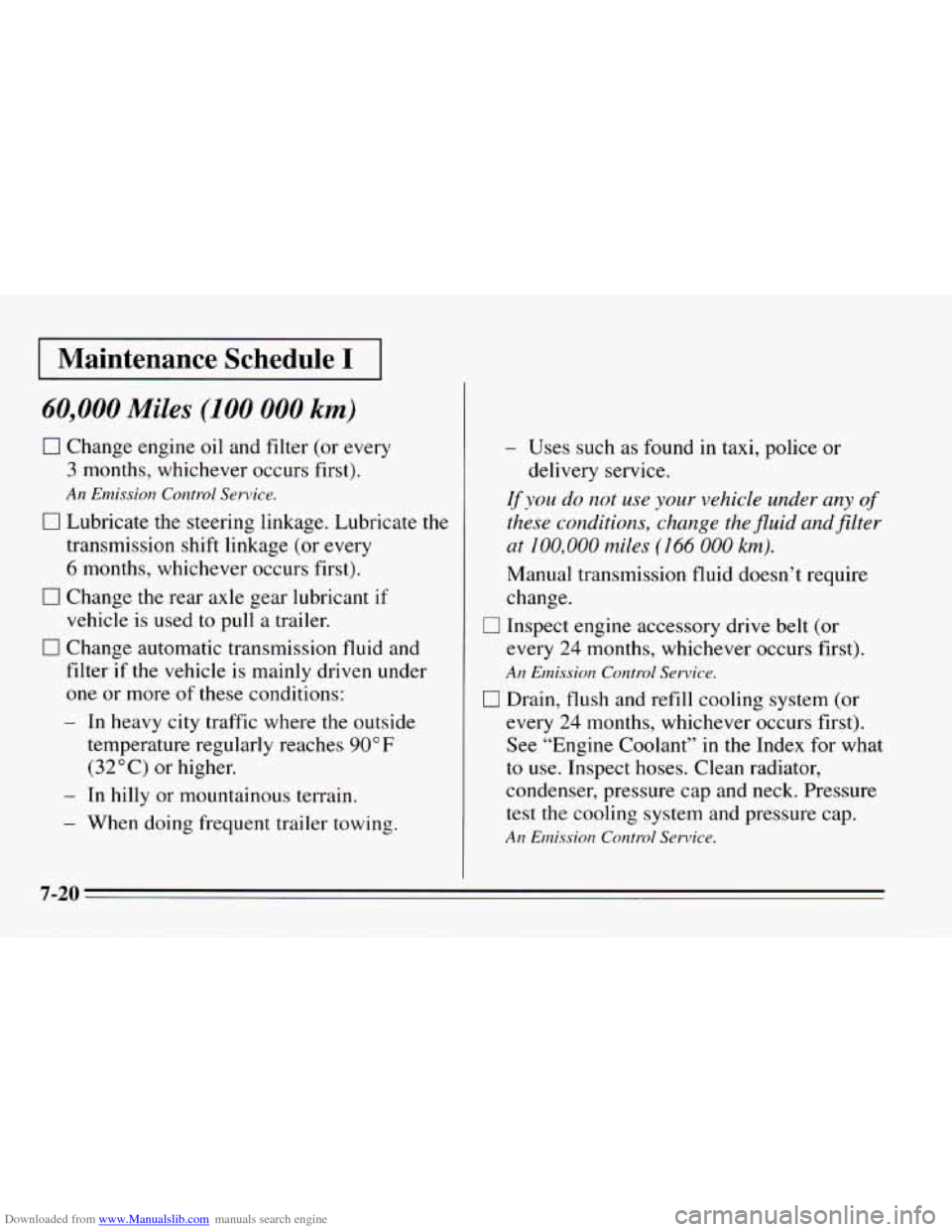
Downloaded from www.Manualslib.com manuals search engine Maintenance Schedule I
60,000 Miles (100 000 km)
0 Change engine oil and filter (or every
3 months, whichever occurs first).
An Emission Control Service.
0 Lubricate the steering linkage. Lubricate the
transmission shift linkage (or every
6 months, whichever occurs first).
0 Change the rear axle gear lubricant if
vehicle is used to pull a trailer.
0 Change automatic transmission fluid and
filter
if the vehicle is mainly driven under
one or more
of these conditions:
- In heavy city traffic where the outside
temperature regularly reaches
90 OF
(32°C) or higher.
- In hilly or mountainous terrain.
- When doing frequent trailer towing.
- Uses such as found in taxi, police or
Ifyou do not use your vehicle under any of
these conditions, change the fluid and filter
at 100,000 miles (I 66 000 km).
Manual transmission fluid doesn’t require
change.
every 24 months, whichever occurs first).
c] Drain, flush and refill cooling system (or
every 24 months, whichever occurs first).
See “Engine Coolant”
in the Index for what
to
use. Inspect hoses. Clean radiator,
condenser, pressure cap and neck. Pressure
test the cooling system and pressure cap.
delivery service.
0 Inspect
engine accessory drive belt (or
An E1nissi01.1 Control Service.
An Elnissiorz Control Service.
7-20
Page 347 of 388
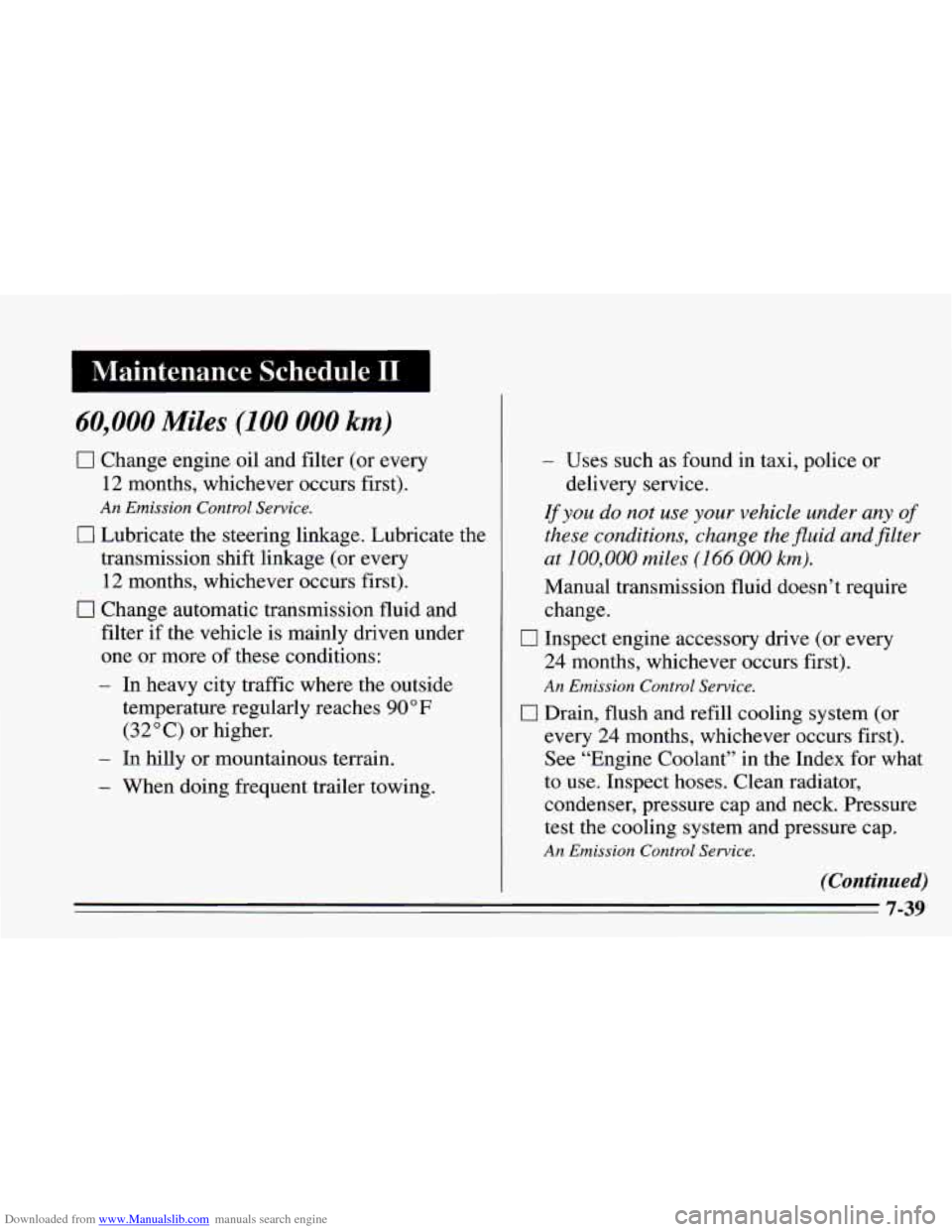
Downloaded from www.Manualslib.com manuals search engine Maintenance Schedule I1 ~ 1
60,000 Miles (100 000 km)
0 Change engine oil and filter (or every
12 months, whichever occurs first).
An Emission Control Service.
0 Lubricate the steering linkage. Lubricate the
transmission shift linkage (or every
12 months, whichever occurs first).
0 Change automatic transmission fluid and
filter
if the vehicle is mainly driven under
one or more
of these conditions:
- In heavy city traffic where the outside
temperature regularly reaches
90 OF
(32 O C) or higher.
- In hilly or mountainous terrain.
- When doing frequent trailer towing.
- Uses such as found in taxi, police or
If you do not use your vehicle under any of
these conditions, change the fluid and filter
at
100,000 miles (166 000 km).
Manual transmission fluid doesn’t require change.
24 months, whichever occurs first).
An Emission Control Service.
delivery service.
0 Inspect engine accessory drive (or every
CI Drain, flush and refill cooling system (or
every
24 months, whichever occurs first).
See “Engine Coolant” in the Index for what
to use. Inspect hoses. Clean radiator,
condenser, pressure cap and neck. Pressure
test the cooling system and pressure cap.
An Emission Control Service.
(Continued)
7-39
Page 353 of 388
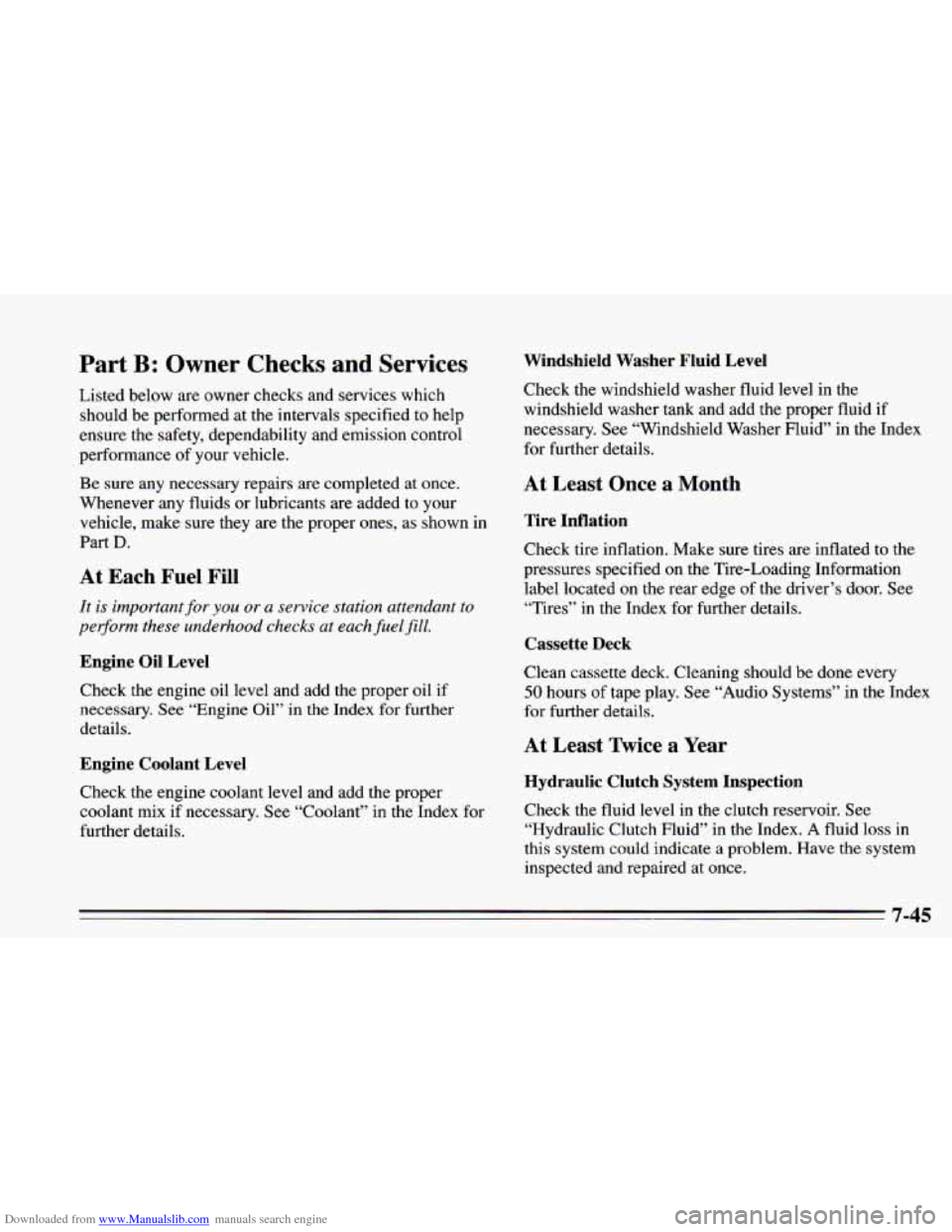
Downloaded from www.Manualslib.com manuals search engine Part B: Owner Checks and Services
Listed below are owner checks and services which
should be performed at the intervals specified to help
ensure the safety, dependability and emission control
performance
of your vehicle.
Be sure any necessary repairs are completed at once.
Whenever any fluids or lubricants are added to your
vehicle, make sure they are the proper ones, as shown in
Part
D.
At Each Fuel Fill
It is important for you or a service station attendant to
pevorm these underhood checks at eachfielfill.
Engine Oil Level
Check the engine oil level and add the proper oil if
necessary. See “Engine Oil” in
the Index for further
details.
Engine Coolant Level
Check the engine coolant level and add the proper
coolant mix if necessary. See “Coolant”
in the Index for
further details.
Windshield Washer Fluid Level
Check the windshield washer fluid level in the
windshield washer tank and add the proper fluid if
necessary. See “Windshield Washer Fluid” in the Index
for further details.
At Least Once a Month
Tire Inflation
Check tire inflation. Make sure tires are inflated to the
pressures specified
on the Tire-Loading Information
label located on the rear edge
of the driver’s door. See
“Tires”
in the Index for further details.
Cassette Deck
Clean cassette deck. Cleaning should be done every
50 hours of tape play. See “Audio Systems” in the Index
for further details.
At Least Twice a Year
Hydraulic Clutch System Inspection
Check the fluid level in the clutch reservoir. See
“Hydraulic Clutch Fluid”
in the Index. A fluid loss in
this system could indicate a problem. Have the system
inspected and repaired at once.
7-45
Page 379 of 388
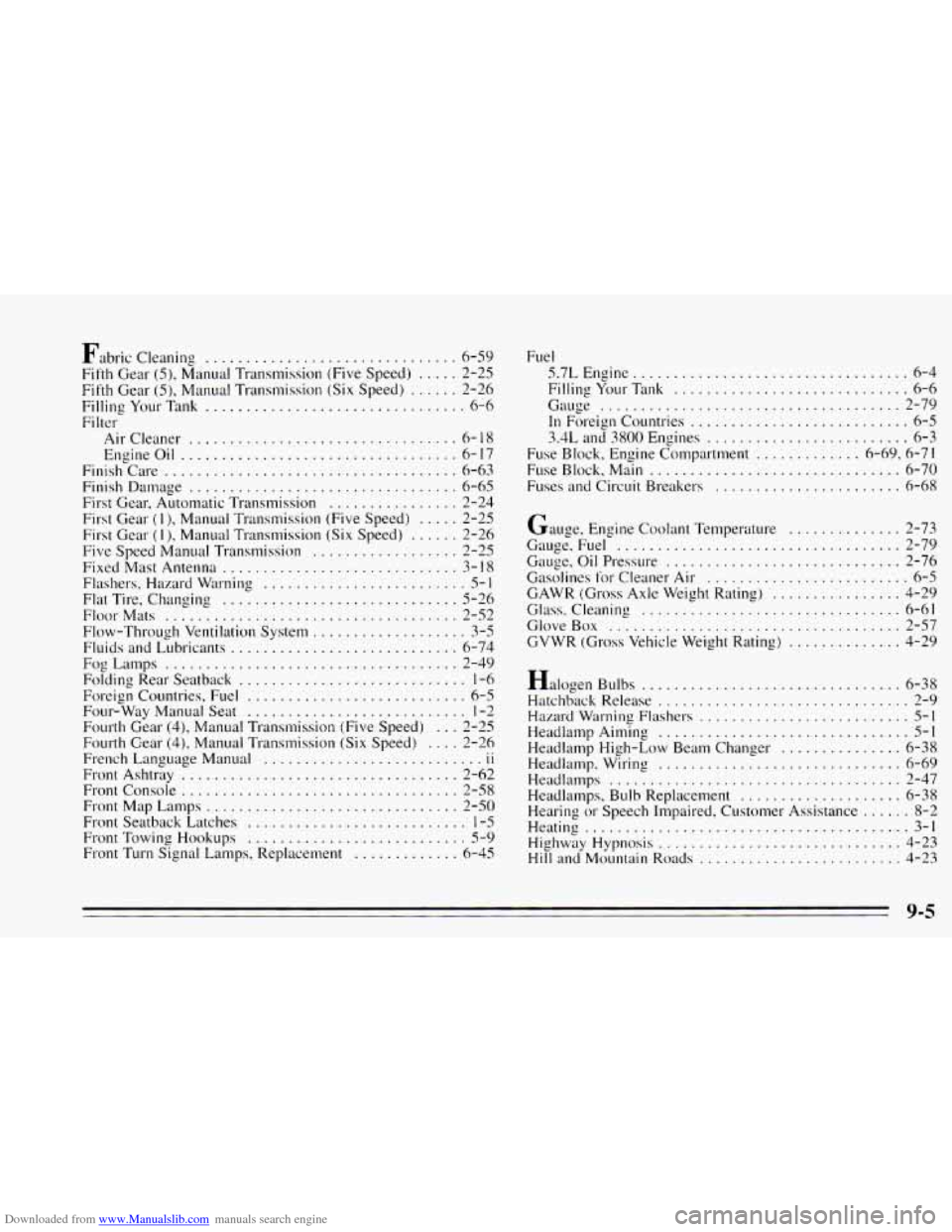
Downloaded from www.Manualslib.com manuals search engine Fabric Cleaning ............................... 6-59
Fifth Gear
(5). Manual Transmission (Five Speed) ..... 2-25
Fifth Gear
(5). Manual Transmission (Six Speed) ...... 2-26
Filling Your Tank
................................ 6-6
Filter
Aircleaner
................................. 6-18
Engine Oil
.................................. 6- I7
Finish Care
.................................... 6-63
Finish Damage
................................. 6-65
First Gear. Automatic Transmission
................ 2-24
First Gear
(1 ). Manual Transmission (Five Speed) ..... 2-25
First Gear
(I). Manual Transmission (Six Speed) ...... 2-26
Five Speed Manual Transmission
.................. 2-25
Fixed Mast Antenna
............................. 3- I8
Flashers. Hazard Warning ......................... 5- 1
Flat Tire. Changing ............................. 5-26
Flow-Through Ventilation Systetn
................... 3-5
Fluids and Lubricants ............................ 6-74
Fog Lamps .................................... 2-49
Folding Rear Seatback
............................ 1-6
Foreign Countries. Fuel
........................... 6-5
Four-Way Manual Seat
........................... 1-2
Fourth Gear (4) . Manual Transmission (Five Speed) ... 2-2s
Fourth Gear
(4) . Manual Transmission (Six Speed) .... 2-26
French Language Manual
11
Front Ashtray .................................. 2-62
Front Console
.................................. 2-58
Front Map Lamps
............................... 2-50
Front Seatback Latches ........................... 1-5
Front Towing Hookups ........................... 5-9
Front Turn Signal Lamps. Replacement ............. 6-45
Fl~ot- Mats .................................... 2-52
.. ...........................
Fuel
5.7L Engine .................................. 6-4
Filling Your Tank
............................. 6-6
Gauge
..................................... 2-79
In Foreign Countries ........................... 6-5
3.4L and
3800 Engines ......................... 6-3
FLW Block. Engine Compartment
............. 6-69. 6-71
Fuse Block.
Man ............................... 6-70
Fuses
and Circuit Breakers ....................... 6-68
Gauge. Engine Coolant Temperature
.............. 2-73
Gauge.Fue1
................................... 2-79
Gauge. Oil Pressure
............................. 2-76
Gasol~nes for Cleaner Air
......................... 6-5
GAWR (Gross Axle Weight Rating)
................ 4-29
Glass . Cleaning ................................ 6-61
GloveBox
.................................... 2-57
GVWR (Gross Vehicle Weight Rating)
.............. 4-29
Halogen Bulbs
................................ 6-38
Hatchback Release
............................... 2-9
Hazard Wunin? Flashers .......................... 5-1
Headlamp Aimrng ............................... 5-1
Headlamp High-Low Beam Changer ............... 6-38
Headlamps
.................................... 2-47
Headlamps. Bulb Replacement
.................... 6-38
Hearing
or Speech Impaired . Customer Assistance ...... 8-2
Highway Hypnosis
.............................. 4-23
Hill and Mountain Roads
......................... 4-23
Headlamp . Wiring .............................. 6-69
Heating ........................................ 3-1
9-5